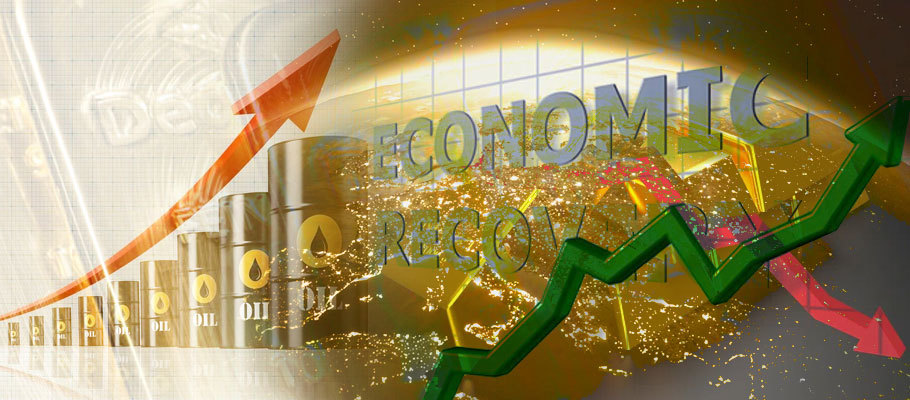
Published: May 7th, 2021
Oil commodity futures inched up this week as Asian investors demonstrated their optimism about prospects for ongoing economic recovery in America and Europe and the likely boost that will give to demand for fuel. However, the rise was slightly muted by spiking COVID-19 infection numbers in other regions, holding back further gains.
Brent crude futures pushed up by 0.03 per cent to reach USD 67.57, West Texas Intermediate (WTI) futures gained by 0.02 per cent to reach USD 64.49.
The moves were sparked in part by European Union announcements that travel curbs might be eased in time for the summertime peak-travel season. In America, manufacturing heavy states on the Eastern Seaboard, including New York, said they planned to end the majority of COVID-19 commercial restrictions and let businesses ease back to normal operations.
Oil futures have moved steadily upward this year as investor confidence grows that coronavirus vaccination programmes will help spur the global economy back to pre-pandemic levels. Chair of the US Federal Reserve, Jerome Powell, added to positive sentiment when he said this week that America’s economic rebound is ‘seeing real progress.’ Powell warned, however, that the road back toward normal remains long and strewn with obstacles.
In terms of oil supply, the Organization of Petroleum Exporting Countries and allies (OPEC+) has been buoyed by the strength of demand seen so far in May and has begun scaling back production cuts, opening the taps for expected growth in exports. OPEC’s second-largest producer, Iraq, is forecasting fuel prices will stay steady at about USD 65 per barrel in the next few months.
On the back of those positive signals, oil commodity investors are now watching what US numbers from the American Petroleum Institute will say about crude oil supply.
Casting a shadow over oil markets, however, is the exploding number of new COVID-19 cases in Asia. India has seen a new variant of the virus rage across the country, passing 20 million new cases at the time of writing, according to data released by Johns Hopkins University researchers. India is the world’s third-largest oil importer.
But while India’s numbers have dominated headlines, numbers are also on the rise elsewhere in Asia. Countries including Thailand, Japan, Laos, Bhutan and Nepal are all reporting a significant upsurge in COVID-19 cases, with numbers rising continually over the past few weeks.
Despite those worries, oil investors have kept up a sunny demeanour this week.
Oil market analysts at Oanda Asia Pacific told investors this week that weak demand in India is a big issue, but ‘the market looks to have moved on, with positive sentiment being driven by success in rolling out vaccination programs in the US, Europe, and elsewhere.’
While oil moves up on good news, positive economic news pushed gold down this week from last week’s highs. A strengthening dollar and investor response to upbeat comments by Fed Chairman Jerome Powell fuelled optimism that saw investor change footing and move away from safe-havens.
Gold futures slipped back by 0.18 per cent to USD 1788.33 on Wednesday.
Back in October, COVID-19 stimulus packages proposed by Washington and Brussels drove worries about currency debasement and had investors buying up gold and pushing prices steadily upward.
Gold crossed the USD 2k per-troy-ounce line for the first time in years, a rise that started as far back as 2015 but shot upward when the Coronavirus outbreak began last February. Retrenchment in dollar yields gave bullion a boost as the Dow Jones Greenback Index fell for five straight months through August. That's all changed, however. At the start of the week, Powell said that America's economy is slowly emerging from its pandemic stupor but cautioned that concerns still remain for a sustained rebound. He took care to outline how low-income families and front line workers had borne the brunt of economic dislocation and joblessness during the coronavirus outbreak and the economic restrictions that followed it.
Positive, if careful, moves have been reflected elsewhere by central banks in major-currency countries. The Bank of Canada said this week that it might begin raising interest rates before the US Federal Reserve. Those comments gave the Canadian dollar a predictable jolt, but previous cycles of rate tightening indicate the boost may be short-lived and not sustainable over the long term.
Energy and precious metals investors are also keeping an eye on policy decisions from the Reserve Bank of Australia regarding interest rates. Sweden’s Norges Bank and the Bank of England will also unveil their interest rate policy decisions in the coming weeks.
Data from across the pond and America’s Institute of Supply Management (ISM) showed a lower-than-expected 60.7 rating in the Manufacturing Purchasing Managers Index (PMI) for April. The surprise drop was driven by a shortage of inputs needed to address pent-up demand coming from the rising COVID-19 inoculation rate and more proposed stimulus measures announced by the White House.
Other data scheduled for release next week include the April US employment report, including non-farm payrolls, and the latest measurement of America’s trade balance and any deficits vis a vis countries like China.
In Asia, the year-on-year South Korean consumer price index (CPI) for April expanded by 2.28 per cent, placing it close to a four-year high. South Korea’s effective COVID response has seen its economy return to normal earlier than many others, giving it a head start on growth and boosting consumer demand.